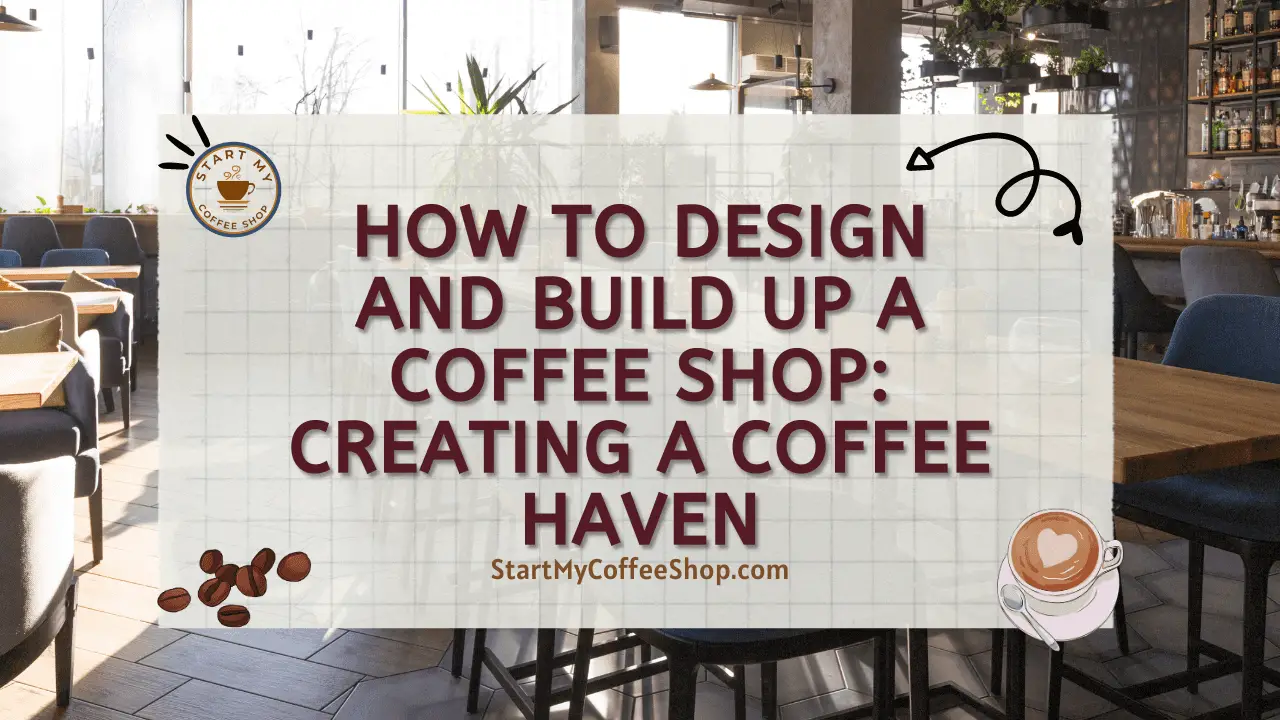Designing and constructing a coffee shop from scratch is a thrilling endeavor that requires careful planning, attention to detail, and a deep understanding of the coffee industry.
To effectively design and build a coffee shop from scratch, consider factors like location, target audience, layout, branding, equipment, permits, and ambiance. Create a detailed plan, hire skilled professionals, prioritize functionality and aesthetics, and ensure compliance with local regulations.
Whether you’re an aspiring entrepreneur or a coffee enthusiast with a vision, this article will walk you through the essential steps to create a great coffee shop.
I. Research and Planning
Identifying Your Target Audience:
 Identifying your target audience is a crucial step in designing and constructing a successful coffee shop. It involves delving into local demographics and understanding coffee consumption patterns prevalent in the area.
Identifying your target audience is a crucial step in designing and constructing a successful coffee shop. It involves delving into local demographics and understanding coffee consumption patterns prevalent in the area.
By analyzing the competition, you can uncover gaps and opportunities in the market. Discovering your unique selling proposition sets you apart from the competition and gives customers a reason to choose your coffee shop.
With this information in hand, you can determine your target market and tailor your offerings to meet their preferences, whether it’s specialty brews, vegan options, or a cozy atmosphere that appeals to a specific demographic.
Choosing the Right Location:
Choosing the right location for your coffee shop is a critical decision that can significantly impact its success. It involves assessing various factors such as foot traffic, visibility, and accessibility to ensure maximum exposure and convenience for customers.
Evaluating the neighborhood’s character helps determine if it aligns with your target market and brand image. Understanding the potential customer base in the area is essential for tailoring your offerings and marketing strategies effectively.
Additionally, carefully considering leasing or purchasing options and negotiating favorable terms can have long-term financial implications. By thoroughly analyzing these aspects, you can find a location that sets the stage for your coffee shop’s growth and profitability.
Developing a Solid Business Plan:
 Developing a solid business plan is a fundamental step in designing and constructing a coffee shop from scratch. It involves defining your concept, mission, and long-term goals to establish a clear direction for your business.
Developing a solid business plan is a fundamental step in designing and constructing a coffee shop from scratch. It involves defining your concept, mission, and long-term goals to establish a clear direction for your business.
Conducting a comprehensive market analysis allows you to understand the competitive landscape, identify potential challenges, and discover untapped opportunities. Financial projections help estimate costs, revenue streams, and profitability, enabling you to make informed decisions.
Additionally, outlining a detailed marketing and branding strategy helps create awareness, attract customers, and build a strong brand identity. A well-crafted business plan serves as a roadmap for success, guiding your coffee shop through its inception and beyond.
Read more about Cost to Open Coffee Shop Average: From Concept to Cash Register
II. Design and Layout
Interior Design and Theme:
 The interior design and theme of your coffee shop play a significant role in shaping the customer experience. It involves defining the atmosphere and ambiance you want to create, whether it’s a cozy and rustic feel or a modern and sleek aesthetic.
The interior design and theme of your coffee shop play a significant role in shaping the customer experience. It involves defining the atmosphere and ambiance you want to create, whether it’s a cozy and rustic feel or a modern and sleek aesthetic.
Selecting appropriate furniture, decor, and color schemes that align with your desired atmosphere is crucial. Comfortable seating arrangements, aesthetically pleasing artwork, and soothing color palettes can enhance the overall ambiance.
Additionally, incorporating branding elements such as logos, signage, and menu boards reinforces your brand identity and creates a cohesive experience for customers. The thoughtful interior design creates a welcoming and visually appealing space that leaves a lasting impression on visitors.
Ergonomics and Functionality:
Ergonomics and functionality are key considerations in the design and construction of a coffee shop. It involves creating an efficient workflow for baristas and staff by strategically positioning workstations, equipment, and storage areas. This ensures smooth operations and minimizes unnecessary movements.
Proper placement of equipment, such as espresso machines, grinders, and beverage stations, enhances productivity and customer service. Careful attention is also given to the layout of counters and seating areas to optimize customer flow and create a pleasant and comfortable environment.
Maximizing space utilization is important in smaller establishments, allowing for efficient use of available square footage while maintaining a spacious and inviting atmosphere for customers to enjoy their coffee experience.
Embracing Sustainability:
 Embracing sustainability in the design and construction of your coffee shop is not only socially responsible but also attracts eco-conscious customers. It involves incorporating eco-friendly materials such as recycled or renewable resources for flooring, furniture, and fixtures. Implementing energy-efficient lighting solutions and equipment, such as LED bulbs and low-energy appliances, reduces energy consumption and lowers operating costs.
Embracing sustainability in the design and construction of your coffee shop is not only socially responsible but also attracts eco-conscious customers. It involves incorporating eco-friendly materials such as recycled or renewable resources for flooring, furniture, and fixtures. Implementing energy-efficient lighting solutions and equipment, such as LED bulbs and low-energy appliances, reduces energy consumption and lowers operating costs.
Furthermore, offering options for recycling and waste management, including designated recycling bins and composting programs, demonstrates your commitment to environmental stewardship. By prioritizing sustainability, you not only reduce your coffee shop’s ecological footprint but also appeal to customers who value sustainable practices, creating a positive brand image and contributing to a greener future.
III. Construction and Equipment
Hiring Professionals:
Hiring professionals for your coffee shop’s design and construction is crucial for a successful outcome. Begin by searching for reputable architects, contractors, and interior designers who specialize in commercial spaces.
Seek recommendations from trusted sources and review portfolios to assess their expertise and style compatibility. Obtain detailed cost estimates from multiple professionals and engage in contract negotiations to ensure clarity regarding timelines, deliverables, and costs.
By hiring skilled professionals, you can leverage their expertise to bring your coffee shop vision to life, ensuring quality craftsmanship and attention to detail throughout the construction process.
Choosing High-Quality Equipment:
Choosing high-quality equipment is essential for the smooth operation of your coffee shop. Select commercial-grade coffee machines, grinders, and brewers that can handle the demands of a busy establishment. Consider factors such as capacity, durability, and features that align with your specific needs and menu offerings.
Additionally, invest in reliable refrigeration systems to store perishable ingredients, water filtration systems to ensure optimal taste in your beverages, and ventilation systems to maintain a comfortable environment for both staff and customers. By prioritizing quality equipment, you can deliver consistent and excellent coffee experiences while minimizing the risk of breakdowns or inefficiencies.
Creating a Functional Workstation:
Creating a functional workstation is crucial to maximizing efficiency and productivity in your coffee shop. Design an ergonomic layout that prioritizes baristas’ comfort and allows for smooth movement between workstations.
Ensure ample storage space for coffee beans, supplies, and utensils, promoting organization and easy access during busy periods. Additionally, incorporate a well-organized service area that streamlines customer orders, with designated stations for order taking, drink preparation, and pick-up.
By optimizing the workstation’s design, you create a seamless workflow that enhances the overall operational efficiency of your coffee shop, resulting in improved customer service and a positive work environment for your staff.
IV. Permits, Regulations, and Compliance
Researching Local Regulations:
Researching local regulations is a vital step in the process of designing and constructing a coffee shop. Familiarize yourself with zoning laws, building codes, and health department requirements applicable to your location.
Consulting with professionals, such as architects and legal advisors, as well as local authorities, ensures a comprehensive understanding of the regulations and guarantees compliance. Obtain the necessary permits, licenses, and certifications required to operate a coffee shop legally and smoothly.
By diligently adhering to these regulations, you create a safe and compliant environment for both customers and employees while avoiding potential fines or legal issues that could hinder your coffee shop’s success.
Health and Safety Considerations:
Health and safety considerations are of paramount importance when designing and constructing a coffee shop. Design a hygienic food preparation area by following industry safety standards and guidelines. Ensure proper ventilation to maintain a fresh and comfortable environment for both staff and customers.
Implement efficient waste disposal systems to promote cleanliness and sanitation. Conduct regular inspections to uphold rigorous cleanliness standards and ensure quality control. By prioritizing health and safety measures, you create a safe and welcoming space where customers can enjoy their coffee, and you establish a reputation for maintaining high standards of cleanliness and hygiene.
Meeting Accessibility Standards:
Meeting accessibility standards is crucial to ensure equal access and inclusivity in your coffee shop. Incorporate features such as ramps, wide doorways, and appropriate seating arrangements to accommodate people with disabilities.
Comply with local accessibility guidelines and regulations, ensuring that your coffee shop is accessible and welcoming to all individuals, regardless of their mobility or special needs.
Read more about Cost to Open Coffee Stand: Evaluating the Financial Commitment to a Coffee Stand
V. Branding, Marketing, and Launch
Developing a Strong Brand Identity:
Developing a strong brand identity is essential for the success of your coffee shop. Start by creating a compelling name, logo, and visual identity that resonate with your target audience. These elements should communicate the essence of your coffee shop and evoke a sense of connection and allure.
Craft a unique brand story and values that differentiate your coffee shop from competitors, giving customers a reason to choose you. Consistency is key – ensure your brand is applied consistently across all touchpoints, from signage to packaging.
By maintaining a cohesive and distinctive brand identity, you establish a strong presence in the market, build customer loyalty, and create a memorable experience that sets your coffee shop apart.
Implementing Effective Marketing Strategies:
Building a robust online presence is crucial in today’s digital age for the success of your coffee shop. Start by creating a user-friendly website that showcases your offerings, location, and brand story.
Utilize various social media platforms to engage with your audience, share captivating content, and build a community around your coffee shop. Leverage digital marketing techniques such as content creation and social media advertising to reach a wider audience and drive traffic to your online platforms.
Collaborate with local influencers to expand your reach, organize events to create buzz, and offer promotions to attract new customers. By embracing digital marketing strategies, you can effectively connect with your target audience, build brand awareness, and drive footfall to your coffee shop.
Preparing for a Successful Launch:
Preparing for a successful launch is crucial to kickstart your coffee shop on the right foot. Begin with a soft opening, inviting a select group of guests to gather feedback and identify areas for improvement.
This allows you to make necessary adjustments before the official launch. Invest time in training your staff to deliver exceptional customer service, ensuring they embody your brand image and values. Their friendly and knowledgeable approach will create a positive impression on customers.
To generate buzz and attract new patrons, plan a grand opening event. This could include special promotions, live music, or collaborations with local businesses. A well-executed launch sets the stage for a thriving coffee shop and builds a loyal customer base.
Summary
Designing and constructing a coffee shop from scratch requires meticulous planning, creativity, and a keen eye for detail. By conducting thorough research, selecting the right location, designing a captivating ambiance, and ensuring compliance with regulations, you can lay the foundation for a successful coffee shop.
Remember to prioritize the quality of your equipment, embrace sustainability, and develop a strong brand identity that resonates with your target audience. With careful execution and a passion for coffee, you can bring your dream coffee shop to life and create a welcoming space where customers can enjoy their favorite brews.
Good luck on your coffee shop journey!
Frequently Asked Questions
Q: How much does it cost to design and construct a coffee shop from scratch?
A: Generally, it can range from tens of thousands to hundreds of thousands of dollars.
Q: What permits and licenses are required to open a coffee shop?
A: Typically, you may need permits for construction, signage, health department compliance, food handling, alcohol (if applicable), and business registration.
Q: How do I choose the best location for my coffee shop?
A: Consider factors such as foot traffic, nearby businesses, demographics of the area, parking availability, and visibility.
To learn more on how to start your own coffee shop checkout my startup documents here
Please note: This blog post is for educational purposes only and does not constitute legal advice. Please consult a legal expert to address your specific needs.

Hi! I’m Shawn Chun
My adventure in coffee began when I first launched my first coffee shop back in the early 2000s. I had to figure out so many things on my own and to make it worse within 2 years of opening two large corporate coffee chains moved in just blocks away from me!
As I saw smaller and even some larger coffee shops in the neighborhood slowly lose customers to these giant coffee chains and slowly close up shop, I knew that I had to start getting creative…or go out of business.
I (like you may be) knew the coffee industry well. I could make the best latte art around and the foam on my caps was the fluffiest you have ever seen. I even had the best state-of-the-art 2 group digital Nuova Simonelli machine money could buy. But I knew that these things alone would not be enough to lure customers away from the name brand established coffee shops.
Eventually, through lots of trial and error as well as perseverance and creativity I did find a way to not only survive but also thrive in the coffee/espresso industry even while those corporate coffee chains stayed put. During those years I learned to adapt and always faced new challenges. It was not always easy, however, in the end, I was the sole survivor independent coffee shop within a 10-mile radius of my location. Just two corporate coffee chains and I were left after that year. All told the corporate coffee chains took down over 15 small independent coffee shops and kiosks and I was the last one standing and thriving.
Along the years I meet others with the same passion for coffee and I quickly learned that it is not only “how good a barista is” that makes a coffee shop successful, but the business side of coffee as well.
Hence why I started this website you are on now. To provide the tools and resources for up and coming coffee shop owners to gain that vital insight and knowledge on how to start a coffee shop successfully.
Stick around, browse through my helpful blog and resources and enjoy your stay! With lots of LATTE LOVE!
Shawn






